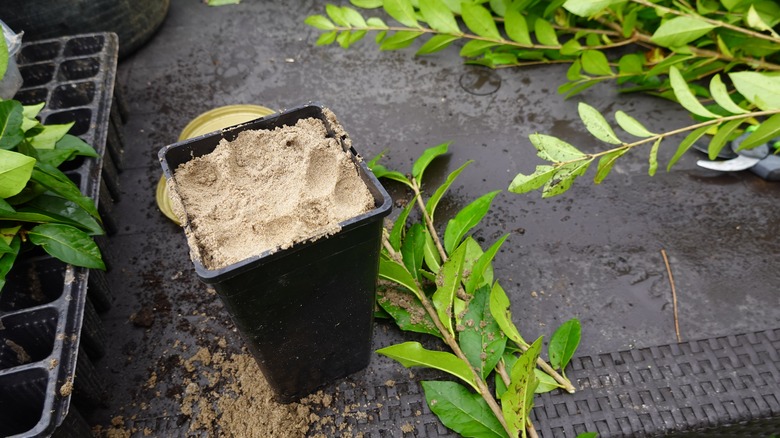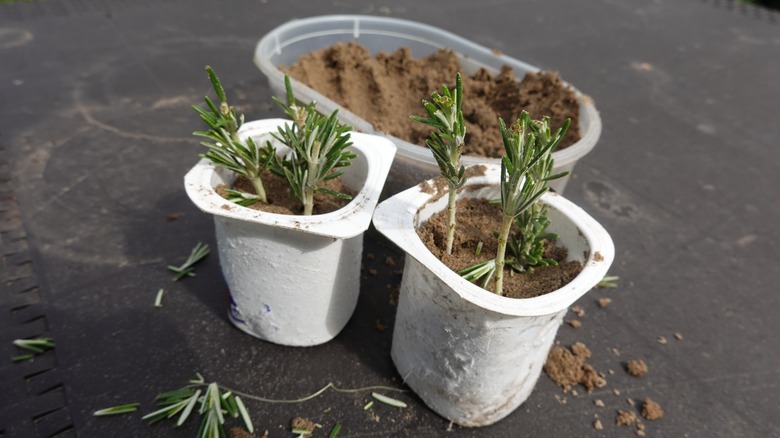Why You Should Be Propagating Your Plants In Sand
Propagation is the process of multiplying existing plants. It allows gardeners and plant enthusiasts to reproduce their favorite varieties, save rare species, and rejuvenate aging ones. Asexual propagation involves growing a new plant from the parent plant's stem, leaves, or roots, while sexual propagation involves germinating new plants from seed. Both methods require a growing medium that provides a nutrient-poor, well-draining environment, as this will facilitate root development.
Numerous options are available for potting mixes that are suitable for sowing seeds and rooting cuttings. However, a lesser-known but equally-effective option is sand. Sand offers excellent drainage, promotes healthy root growth, and reduces the risk of root rot. Its versatility even makes it suitable for various plant types, including succulents, herbs, fruit trees, and shrubs. Propagation is a great way to give your dying houseplants new life, and using this cost-effective, readily-available substrate can give your cuttings and seedlings the best start.
How sand creates the perfect environment for propagated plants
An optimal substrate should provide conditions that support healthy roots and facilitate development into strong, established plants. The substrate should be well-draining, and sand allows water to pass through quickly, preventing waterlogging and ensuring aeration for developing roots. This allows oxygen to flow through while preventing problems such as root rot.
Sand also provides the sterile and nutrient-poor environment that the young plants need. Choosing an inert substrate like sand is crucial for protecting seedlings and cuttings from fungal diseases such as damping off and weed seeds that may be present in garden soil and compost. Additionally, a growing medium that is too fertile can inhibit the growth of strong, healthy roots for very young plants — because sand isn't fertile, this makes it an ideal option for propagation. The texture of sand also provides stability and support for delicate cuttings, preventing them from shifting or becoming dislodged during the rooting process. This encourages the formation of strong root systems, which are essential for the long-term growth and vitality of propagated plants.
Types of sand and tips for successful propagation
Coarse sand, also referred to as horticultural sand, is the preferred choice for plant propagation, although paver and play sands are also suitable. Consider that fine sands can compact easily and suffocate roots — a great option is to mix finer sands with another growing medium to provide a looser structure and good aeration. Experimenting with different combinations of sand and other mediums — such as coir, peat moss, perlite, and vermiculite — can help tailor the propagation environment to each species.
There are plenty of plants and herbs you can easily propagate from cuttings, including basil, rosemary, and coleus. For many herbs and tender perennials, simply fill a cup or yogurt container with wet sand. Remove the lower leaves from the stem of your cutting and insert the cut edge vertically into the sand so that it is held upright. For certain hardwood cuttings such as fig trees, lay the cuttings horizontally onto the sand's surface. Maintain a moist and humid environment and keep the plants in a warm location until roots develop. A rooting hormone can be applied to the cut edge or the nodes to aid successful rooting as well.
For seed propagation, fill trays or pots with sand — or a blend of sand, vermiculite, or seedling mix. Sow seeds evenly, and lightly cover them with more sand. Keep the substrate consistently-moist but not waterlogged. Provide warmth, humidity, and bright light, and transplant seedlings once they've developed sturdy roots.

